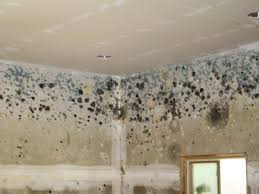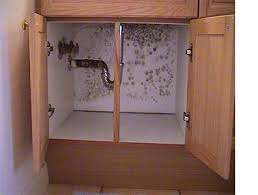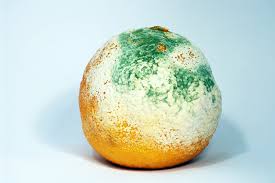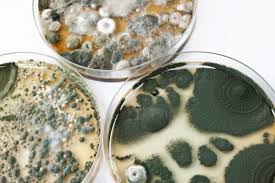![]() Prinitable PDF Mold and Your Home
Prinitable PDF Mold and Your Home
Molds are naturally occurring microscopic fungi that, when in nature, feed on plant or animal matter.
Mold and Your Home
What are molds?
BE SURE TO REVIEW THE "PDF" AT THE TOP OF THIS ARTICLE FOR IMAGES AND FURTNER INFORMATION
 Molds are naturally occurring microscopic fungi that, when in nature, feed on plant or animal matter. It is estimated that there could be ten’s to hundred’s of thousands of species of fungi. Fungi & mold are very important in the natural decomposition of plant & animal matter. Fungi make up approximately 25% of earth’s biomass. Some fungi and molds are considered foods and delicacies, i.e. mushrooms, yogurt, yeast, & cheese. Mold is also used in medicines like penicillin. Molds are common in residential homes and most species found in their typical concentrations are benign and have no adverse effects on healthy individuals. Elevated concentrations of mold and some types of molds can have adverse health effects on some people.
Molds are naturally occurring microscopic fungi that, when in nature, feed on plant or animal matter. It is estimated that there could be ten’s to hundred’s of thousands of species of fungi. Fungi & mold are very important in the natural decomposition of plant & animal matter. Fungi make up approximately 25% of earth’s biomass. Some fungi and molds are considered foods and delicacies, i.e. mushrooms, yogurt, yeast, & cheese. Mold is also used in medicines like penicillin. Molds are common in residential homes and most species found in their typical concentrations are benign and have no adverse effects on healthy individuals. Elevated concentrations of mold and some types of molds can have adverse health effects on some people.
Among the types of molds are:
Allergenic: which are normally not dangerous in low amounts but can cause allergic or asthmatic symptoms.
allergic or asthmatic symptoms.
Mycotoxic: molds can cause health effects ranging from short term irritation to immunosuppression, etc.
Pathogenic: molds can cause serious health effects in persons with autoimmune disorders or other conditions.
What is Black Mold?
Stachybotrys chartarum is the mold that is commonly referred to as “The Black Mold” or “Toxic Mold” in the media and other circles. Stachybotrys is commonly found in soils and yard debris around your home and may grow on wet surfaces inside your home. If you garden or work in the yard you are probably exposed to “Stachy” regularly with no ill effects. At one recent mold seminar there was anecdotal evidence presented of a woman gardener died of exposure to “Stachy” but it was noted she had a habit of licking her hands while working the garden. While elevated concentrations of “Stachy” can cause health issues in some people there are some 15 species, some of which are not typically a concern, and subsequent testing would have to be performed to determine if it is a pathogenic or mycotoxic species. Other molds fall into this classification also.
How can mold grow in my home?
To grow, mold typically needs warmth, water, & food. Water leaks in roofs, window and door openings, air conditioning systems, and plumbing fixtures are the most common causes of elevated & destructive mold growth. Interior wall spaces which trap moisture & interior wall surfaces warmed from the outside which are behind heavy drapes or in closets behind clothes can become micro climates where still air can become humid and present a hospitable climate. Mold can grow in the ducts of improperly maintained air conditioning equipment.
Cellulose, found in sheetrock & wallpaper glue, is an excellent source of food, as are leather, cotton, & bacteria. Normal living temperatures along with elevated humidity levels can sustain mold growth. In the home it is important to maintain proper humidity levels to prevent growth. Although mold can only grow on wet surfaces, its spores (microscopic seeds) can become airborne and spread to contaminate other locations. Typically, unless growing (wet), mold spores cannot pass through most interior surfaces (sheetrock) when properly finished. When breathed in, the spores can be an irritant or worse.
What would be a dangerous concentration of mold?
Currently there are no national standards for regulating concentrations of specific molds, degrees of exposure, or methods of abatement which would determine a specific hazardous condition. Neither is there definitive scientific evidence that a specific exposure to a measured concentration of a particular mold would have an adverse health effects on a particular group of people. If suspect concentrations are noted your physician should be consulted.
Can indoor mold harm me?
 Only your personal physician can advise you weather a specific concentration or type of mold can be harmful to you considering your present physical condition. It is agreed by most that an Epidemiologist is the only person with the education to determine if specific concentrations of molds can be harmful to a group of people. An Epidemiologist’s is a scientist who studies how often, in whom, and why a disease occurs in a population. An epidemiologist looks at the sum of the factors controlling the presence or absence of a disease and the possible causes (eg, coming into contact with a hazardous substance).
Only your personal physician can advise you weather a specific concentration or type of mold can be harmful to you considering your present physical condition. It is agreed by most that an Epidemiologist is the only person with the education to determine if specific concentrations of molds can be harmful to a group of people. An Epidemiologist’s is a scientist who studies how often, in whom, and why a disease occurs in a population. An epidemiologist looks at the sum of the factors controlling the presence or absence of a disease and the possible causes (eg, coming into contact with a hazardous substance).
Under certain metabolic conditions, many fungi produce mycotoxins which are natural organic compounds that initiate a toxic response in some Persons when inhaled. Some mold concentrations appear to have adverse health effects in persons with respiratory problems, auto-immune disorders, the young, and others with specific health disorders.
Although some factors may produce variables, an air born mold spore count above that of the outside count is usually considered a condition in need of further investigation.
Can molds harm my home?
Mold can cause permanent damage to many surfaces and belongings in your home. They can also be a warning sign to a more dangerous presence, water. Water will attract many pests including ants and some types of termites. It can cause wood rot and decay. It can also promote the growth of fungus which can accelerate wood damage. Hidden water damage can cause sections of roofs to fail, ceilings to collapse, electric systems to short, bath tiles to fall off walls, and cabinets to warp and decay.
water. Water will attract many pests including ants and some types of termites. It can cause wood rot and decay. It can also promote the growth of fungus which can accelerate wood damage. Hidden water damage can cause sections of roofs to fail, ceilings to collapse, electric systems to short, bath tiles to fall off walls, and cabinets to warp and decay.
What is a mold inspection?
During an inspection many areas of the dwelling can not be accessed for review. Invasive procedures including cutting through sheetrock, pulling up cabinet bases, or removing carpeting is typically frowned on by the current owner. Additionally interior walls, many areas of attics, most of the A/C ducts, behind cabinets, and other areas can not be accessed.
Typically a mold inspection, within the confines of a home inspection, would consist of investigating the structure for signs of water leaks in the roof and exterior structure, followed by a review of the accessible attics, interior rooms, accessible air conditioning ducts, and cabinets for evidence of water leaks or visible mold growth on surfaces. The interior humidity levels would be noted.
A more detailed investigation would include the collection of air samples in interior rooms, possibly air sampling of interior wall spaces, and collection of visible samples. These would then be tested in a laboratory for type & concentration. These samples are typically charged per sample collected and submitted for testing.
The amount of samples taken would depend on the volume of the structure, reason for testing (knowledge of prior mold or water conditions), observed conditions at time of testing, personal knowledge of individual susceptibility to contamination, etcetera.
If no specific contamination was suspected, in a house less than 2000 square feet of air conditioned space, typically one sample would be taken near the air return of each air conditioning system, and one outside as a base line. The air conditioning should be running for at least 15min to a half hour before sampling. And the doors and windows should be closed for at least a day.
Who can test for mold?
 There are presently no regulations in the state of Florida regarding the performance of mold inspections in the state of Florida. Many trade and testing organizations offer courses which can range from minimal to intensive and provide the attendee “Certification as a Mold Inspector” with the value of the particular paper it is printed on. A basic background in the causes and behaviors of mold is valuable but in depth scientific knowledge of mold and related issues is not necessary for the collection of samples. It is the testing labs job to determine the type and concentration of spores in the samples. More important is the inspector’s knowledge of your structure and its potential weak points, his method of observation, and depth of investigation. The testing lab should be licensed, accredited, and certified by a number of state and associated trade organizations and have a proven history.
There are presently no regulations in the state of Florida regarding the performance of mold inspections in the state of Florida. Many trade and testing organizations offer courses which can range from minimal to intensive and provide the attendee “Certification as a Mold Inspector” with the value of the particular paper it is printed on. A basic background in the causes and behaviors of mold is valuable but in depth scientific knowledge of mold and related issues is not necessary for the collection of samples. It is the testing labs job to determine the type and concentration of spores in the samples. More important is the inspector’s knowledge of your structure and its potential weak points, his method of observation, and depth of investigation. The testing lab should be licensed, accredited, and certified by a number of state and associated trade organizations and have a proven history.
Should I test my home for mold?
Whether or not you request air sampling is a decision only you can make, depending on your degree of comfort with the homes condition and your personal health concerns. The information provided by air sampling may divulge a hidden condition.
But, according to The American Industrial Hygiene Association “Probably not. It should not be your first step. Your first step should be to inspect your home for any evidence of water damage and any visible mold growth. Testing for mold is expensive, and you should have a clear reason for doing so. In most cases, it is not economically practical or useful to test for mold growth on surfaces or for airborne spores in the home. Testing also tells you little about where mold is located and how to clean it up. In addition, there are no standards for "acceptable" levels of mold in buildings, so when testing is done, it is usually to compare the levels and types of mold spores found inside the home with those found outside the home. If you know you have a mold problem, it is more important to spend time and resources to get rid of the mold and solve the moisture problem causing the moldy conditions rather than testing.
What can cause variations in my mold sampling results?
 An air sampling for mold concentrations is a “snapshot in time” of the air in a particular location and changes in the structure or variables at the time of sampling can affect the results. If the house has been ventilated or if air cleaning has been performed prior to testing false low’s “safe levels” could result. Recent rain or windy conditions outside would lower exterior spore concentrations causing false elevated levels indoors. Homes which have been vacant for a period of time can show false elevated levels because of lack of surface cleaning. If the air conditioning is not running air born spores may not properly circulate throughout the testing area. New sources of water infiltration or changes in living habits may create favorable conditions post testing.
An air sampling for mold concentrations is a “snapshot in time” of the air in a particular location and changes in the structure or variables at the time of sampling can affect the results. If the house has been ventilated or if air cleaning has been performed prior to testing false low’s “safe levels” could result. Recent rain or windy conditions outside would lower exterior spore concentrations causing false elevated levels indoors. Homes which have been vacant for a period of time can show false elevated levels because of lack of surface cleaning. If the air conditioning is not running air born spores may not properly circulate throughout the testing area. New sources of water infiltration or changes in living habits may create favorable conditions post testing.
What do I do if questionable levels of mold are detected?
As mentioned there are no recognized standards for levels of contamination. Because of concerns which developed in a city housing project New York City has developed standards regarding different methods of cleanup for degrees of contamination. Common sense should rule your decisions. Minor infestations of mold and contamination can be eliminated with proper precautions and cleaning along with elimination of the food source “water”.
If no evident source of the mold growth is noted or contamination is over a large area a reputable remediation company should be contracted to perform investigative procedures to locate the source, properly remove contaminated materials, and make necessary repairs.
How do I prevent mold in my home?
Proper maintenance and observation is your key to all aspects of a healthy and well maintained home. Regularly perform the following:
- Check your roof, exterior walls, and openings for signs of water infiltration and perform needed repairs.
- Maintain proper exterior drainage by keeping the ground sloped from the house, have proper gutters which take the water away from the house.
- Service air conditioners regularly.
- Use proper ventilation in baths and when cooking.
- Do not store large items which inhibit air flow against exterior walls.
- Keep closets properly ventilated.
- Keep bath and kitchen faucets and fixtures in proper repair.
- Check counters in kitchens and vanities for proper caulking and tiles in baths and showers for
- proper grouting.
- Remove any interior standing water immediately and dry wet surfaces
- Keep indoor humidity levels below 60%
For more information check:
The EPA’s publication “A Brief Guide to Mold”
The New York City Dept of Health standards for mold abatement
More information from the EPA
The American Industrial Hygiene Association




















